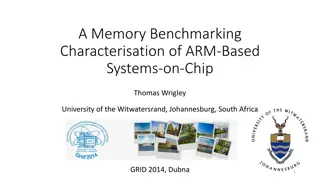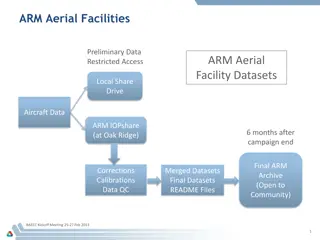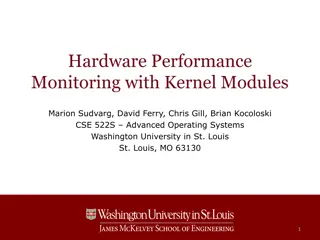
ARM Load Store Instructions Overview
Learn about ARM load/store instructions, data transfer between memory and registers, single register data transfer, and more in computer organization and systems programming. Understand the concepts of memory access, data processing efficiency, and ARM architecture.
Download Presentation

Please find below an Image/Link to download the presentation.
The content on the website is provided AS IS for your information and personal use only. It may not be sold, licensed, or shared on other websites without obtaining consent from the author. If you encounter any issues during the download, it is possible that the publisher has removed the file from their server.
You are allowed to download the files provided on this website for personal or commercial use, subject to the condition that they are used lawfully. All files are the property of their respective owners.
The content on the website is provided AS IS for your information and personal use only. It may not be sold, licensed, or shared on other websites without obtaining consent from the author.
E N D
Presentation Transcript
Data Data Transfer Instructions Transfer Instructions CSE 30: Computer Organization and Systems Programming CSE 30: Computer Organization and Systems Programming Diba Mirza Diba Mirza Dept. of Computer Science and Engineering University of California, San Diego Dept. of Computer Science and Engineering University of California, San Diego
Assembly Operands: Memory Assembly Operands: Memory Memory: Think of as single one-dimensional array where each cell Stores a byte size value Is referred to by a 32 bit address e.g. value at 0x4000 is 0x0a 0x0a 0x4000 0x4001 0x4002 0x0b 0x0c 0x0d 0x4003 Data is stored in memory as: variables, arrays, structures But ARM arithmetic instructions only operate on registers, never directly on memory. Data transfer instructions transfer data between registers and memory: Memory to register or LOAD from memory to register Register to memory or STORE from register to memory
Load/Store Instructions Load/Store Instructions The ARM is a Load/Store Architecture: Does not support memory to memory data processing operations. Must move data values into registers before using them. This might sound inefficient, but in practice isn t: Load data values from memory into registers. Process data in registers using a number of data processing instructions which are not slowed down by memory access. Store results from registers out to memory.
Load/Store Instructions Load/Store Instructions The ARM has three sets of instructions which interact with main memory. These are: Single register data transfer (LDR/STR) Block data transfer (LDM/STM) Single Data Swap (SWP) The basic load and store instructions are: Load and Store Word or Byte or Halfword LDR / STR / LDRB / STRB / LDRH / STRH
Single register data transfer Single register data transfer STR Word STRB Byte STRH Halfword Signed byte load Signed halfword load LDR LDRB LDRH LDRSB LDRSH Memory system must support all access sizes Syntax: LDR{<cond>}{<size>} Rd, <address> STR{<cond>}{<size>} Rd, <address> e.g. LDREQB
Data Transfer: Memory to Register Data Transfer: Memory to Register To transfer a word of data, we need to specify two things: Register: r0-r15 Memory address: more difficult How do we specify the memory address of data to operate on? We will look at different ways of how this is done in ARM Remember: Load value/data FROM memory
Addressing Modes Addressing Modes There are many ways in ARM to specify the address; these are called addressing modes. Two basic classification 1. Base register Addressing Register holds the 32 bit memory address Also called the base address 2. Base Displacement Addressing mode An effective address is calculated : Effective address = < Base address +offset> Base address in a register as before Offset can be specified in different ways
Base Register Addressing Modes Base Register Addressing Modes Specify a register which contains the memory address In case of the load instruction (LDR) this is the memory address of the data that we want to retrieve from memory In case of the store instruction (STR), this is the memory address where we want to write the value which is currently in a register Example: [r0] specifies the memory address pointed to by the value in r0
Data Transfer: Memory to Register Data Transfer: Memory to Register Load Instruction Syntax: 1 2, [3] where 1) operation name 2) register that will receive value 3) register containing pointer to memory ARM Instruction Name: LDR (meaning Load Register, so 32 bits or one word are loaded at a time)
Data Transfer: Memory to Register Data Transfer: Memory to Register LDR r2,[r1] This instruction will take the address in r1, and then load a 4 byte value from the memory pointed to by it into register r2 Note: r1 is called the base register Memory r2 r1 0x200 0x201 0x202 0x203 0xddccbbaa 0x200 0xaa 0xbb 0xcc 0xdd Base Register Destination Register for LDR
Data Transfer: Register to Memory Data Transfer: Register to Memory STR r2,[r1] This instruction will take the address in r1, and then store a 4 byte value from the register r2 to the memory pointed to by r1. Note: r1 is called the base register Memory r2 r1 0x200 0x201 0x202 0x203 0xddccbbaa 0x200 0xaa 0xbb 0xcc 0xdd Base Register Source Register for STR
Base Displacement Addressing Mode Base Displacement Addressing Mode To specify a memory address to copy from, specify two things: A register which contains a pointer to memory A numerical offset (in bytes) The effective memory address is the sum of these two values. Example: [r0,#8] specifies the memory address pointed to by the value in r0, plus 8 bytes
Base Displacement Addressing Mode Base Displacement Addressing Mode 1. Pre-indexed addressing syntax: I. Base register is not updated LDR/STR <dest_reg>[<base_reg>,offset] Examples: LDR/STR r1 [r2, #4]; offset: immediate 4 ;The effective memory address is calculated as r2+4 LDR/STR r1 [r2, r3]; offset: value in register r3 ;The effective memory address is calculated as r2+r3 LDR/STR r1 [r2, r3, LSL #3]; offset: register value *23 ;The effective memory address is calculated as r2+r3*23
Base Displacement Addressing Mode Base Displacement Addressing Mode 1. Pre-indexed addressing: I. Base register is not updated: LDR/STR <dest_reg>[<base_reg>,offset] II. Base register is first updated, the updated address is used LDR/STR <dest_reg>[<base_reg>,offset]! Examples: LDR/STR r1 [r2, #4]!; offset: immediate 4 ;r2=r2+4 LDR/STR r1 [r2, r3]!; offset: value in register r3 ;r2=r2+r3 LDR r1 [r2, r3, LSL #3]!; offset: register value *23 ;r2=r2+r3*23
Base Displacement, Pre Base Displacement, Pre- -Indexed Indexed Example: LDR r0,[r1,#12] This instruction will take the pointer in r1, add 12 bytes to it, and then load the value from the memory pointed to by this calculated sum into register r0 Example: STR r0,[r1,#-8] This instruction will take the pointer in r0, subtract 8 bytes from it, and then store the value from register r0 into the memory address pointed to by the calculated sum Notes: r1 is called the base register #constant is called the offset offset is generally used in accessing elements of array or structure: base reg points to beginning of array or structure
Pre indexed addressing Pre indexed addressing What is the value in r1 after the following instruction is executed? A. 0x200 B. 0x1fc C. 0x196 D. None of the above STR r2,[r1, #-4]! Memory r1 r2 0x20_ 0x20_ 0x20_ 0x20_ 0xddccbbaa 0x200 0xaa 0xbb 0xcc 0xdd Base Register Destination Register for LDR
Base Displacement Addressing Mode Base Displacement Addressing Mode 1. Post-indexed addressing:Base register is updated after load/store LDR/STR <dest_reg>[<base_reg>] ,offset Examples: LDR/STR r1 [r2], #4; offset: immediate 4 ;Load/Store to/from memory address in r2, update r2=r2+4 LDR/STR r1 [r2], r3; offset: value in register r3 ;Load/Store to/from memory address in r2, update r2=r2+r3 LDR r1 [r2] r3, LSL #3; offset: register value left shifted ;Load/Store to/from memory address in r2, update r2=r2+r3*23
Post Post- -indexed Addressing Mode indexed Addressing Mode Memory * Example: STR r0, [r1], #12 r0 0x5 r1 Offset 12 Source Register for STR Updated Base Register 0x20c 0x20c 0x5 0x200 r1 Original Base Register 0x200 * If r2 contains 3, auto-increment base register to 0x20c by multiplying this by 4: STR r0, [r1], r2, LSL #2 * To auto-increment the base register to location 0x1f4 instead use: STR r0, [r1], #-12
Using Addressing Modes Efficiently Using Addressing Modes Efficiently * Imagine an array, the first element of which is pointed to by the contents of r0. * If we want to access a particular element, then we can use pre-indexed addressing: r1 is element we want. LDR r2, [r0, r1, LSL #2] Memory Offset element 3 12 Pointer to start of array 2 8 * If we want to step through every element of the array, for instance to produce sum of elements in the array, then we can use post-indexed addressing within a loop: r1 is address of current element (initially equal to r0). LDR r2, [r1], #4 Use a further register to store the address of final element, so that the loop can be correctly terminated. 1 4 r0 0 0
Pointers vs. Values Pointers vs. Values Key Concept: A register can hold any 32-bit value. That value can be a (signed) int, an unsigned int, a pointer (memory address), and so on If you write ADD r2,r1,r0 then r0 and r1 better contain values If you write LDR r2,[r0] then [r0] better contain a pointer Don t mix these up!
Compilation with Memory Compilation with Memory What offset in LDR to select A[8] in C? 4x8=32 to select A[8]: byte vs word Compile by hand using registers: g = h + A[8]; g: r1, h: r2, r3:base address of A 1st transfer from memory to register: LDR r0,[r3, #32] ; r0 gets A[8] Add 32 to r3 to select A[8], put into r0 Next add it to h and place in g ADD r1,r2,r0 ; r1 = h+A[8]
Logical Shifts, Addressing modes in ARM Arithmetic Data Transfer Instructions Logical Shifts, Addressing modes in ARM Arithmetic Data Transfer Instructions
Shifts and Rotates Shifts and Rotates LSL logical shift by n bits multiplication by 2n 0 C LSR logical shift by n bits unsigned division by 2n 0 C ASR arithmetic shift by n bits signed division by 2n C ROR logical rotate by n bits 32 bit rotate C 23 23
01101001 << 2 01101001 << 2 A. 00011010 B. 00101001 C. 01101001 D. 10100100 24 24
A new instruction HEXSHIFTRIGHT shifts hex numbers over by a digit to the right. A new instruction HEXSHIFTRIGHT shifts hex numbers over by a digit to the right. HEXSHIFTRIGHT HEXSHIFTRIGHT i i times is equivalent to times is equivalent to A. Dividing by i B. Dividing by 2i C. Dividing by 16i D. Multiplying by 16i 25 25
A new instruction HEXSHIFTRIGHT shifts hex numbers over by a digit to the right. A new instruction HEXSHIFTRIGHT shifts hex numbers over by a digit to the right. HEXSHIFTRIGHT HEXSHIFTRIGHT i i times is equivalent to times is equivalent to A. Dividing by i B. Dividing by 2i C. Dividing by 16i D. Multiplying by 16i 26 26
Ways of specifying operand 2 Ways of specifying operand 2 Opcode Destination, Operand_1, Operand_2 Register Direct: With shift/rotate: Shift value: 5 bit immediate (unsigned integer) ADD r0, r1, r2, LSL #2; r0=r1+r2<<2; r0=r1+4*r2 Shift value: Lower Byte of register: ADD r0, r1, r2, LSL r3; r0=r1+r2<<r3; r0=r1+(2^r3)*r2 Immediate: ADD r0, r1, #0xFF With rotate-right ADD r0,r1, #0xFF, 28 Rotate value must be even: #0xFF ROR 28 generates: 0XFF00000000 ADD r0, r1, r2; 1) 2) 27 27
Ways of specifying operand 2 Ways of specifying operand 2 Opcode Destination, Operand_1, Operand_2 Register Direct: With shift/rotate: Shift value: 5 bit immediate (unsigned integer) ADD r0, r1, r2, LSL #2; r0=r1+r2<<2; r0=r1+4*r2 Shift value: Lower Byte of register: ADD r0, r1, r2, LSL r3; r0=r1+r2<<r3; r0=r1+(2^r3)*r2 Immediate addressing: 8 bit immediate value With rotate-right ADD r0,r1, #0xFF, 8 Rotate value must be even #0xFF ROR 8 generates: 0XFF000000 Maximum rotate value is 30 ADD r0, r1, r2; 1) 2) ADD r0, r1, #0xFF 28 28
Reasons for constraints on Immediate Addressing Reasons for constraints on Immediate Addressing The data processing instruction format has 12 bits available for operand2 11 8 7 0 rot immed_8 0xFF000000 MOV r0, #0xFF,8 Immed_8=0xFF, rot =4 x2 Shifter ROR 4 bit rotate value (0-15) is multiplied by two to give range 0-30 in steps of 2 Rule to remember is 8-bits rotated right by an even number of bit positions 29 29
Generating Constants using immediates Generating Constants using immediates Rotate Value 0 Right, 30 bits Right, 28 bits Right, 26 bits Binary 000000000000000000000000xxxxxxxx 0000000000000000000000xxxxxxxx00 00000000000000000000xxxxxxxx0000 000000000000000000xxxxxxxx000000 Decimal 0-255 4-1020 16-4080 128-16320 Hexadecimal 0-0xFF 0x4-0x3FC 0x10-0xFF0 0x40-0x3FC0 Right, 8 bits xxxxxxxx000000000000000000000000 16777216- 255x224 - - - 0x1000000- 0xFF000000 - - - Right, 6 bits Right, 4 bits Right, 2 bits xxxxxx0000000000000000000000xx xxxx0000000000000000000000xxxx xx0000000000000000000000xxxxxx This scheme can generate a lot, but not all, constants. Others must be done using literal pools (more on that later) 30 30
Implementation in h/w using a Barrel Shifter Implementation in h/w using a Barrel Shifter 1. Register, optionally with shift operation Shift value can either be: 5 bit unsigned integer Specified in bottom byte of another register. Used for multiplication by constant 2. Immediate value 8 bit number, with a range of 0-255. Rotated right through even number of positions Allows increased range of 32-bit constants to be loaded directly into registers Operand 1 Operand 2 Barrel Shifter ALU Result 31 31
Shifts and Rotates Shifts and Rotates Shifting in Assembly Examples: MOV r4, r6, LSL #4 ; r4 = r6 << 4 MOV r4, r6, LSR #8 ; r4 = r6 >> 8 Rotating in Assembly Examples: MOV r4, r6, ROR #12 ; r4 = r6 rotated right 12 bits ; r4 = r6 rotated left by 20 bits (32 -12) Therefore no need for rotate left. 32 32
Variable Shifts and Rotates Variable Shifts and Rotates Also possible to shift by the value of a register Examples: MOV r4, r6, LSL r3 ; r4 = r6 << value specified in r3 MOV r4, r6, LSR #8 ; r4 = r6 >> 8 Rotating in Assembly Examples: MOV r4, r6, ROR r3 ; r4 = r6 rotated right by value specified in r3 33 33
Constant Multiplication Constant Multiplication Constant multiplication is often faster using shifts and additions MUL r0, r2, #8 ; r0 = r2 * 8 Is the same as: MOV r0, r2, LSL #3 ; r0 = r2 * 8 Constant division MOV r1, r3, ASR #7 ; r1 = r3/128 Treats the register value like signed values (shifts in MSB). Vs. MOV r1, r3, LSR #7 ; r1 = r3/128 Treats register value like unsigned values (shifts in 0) 34 34
Constant Multiplication Constant Multiplication Constant multiplication with subtractions MUL r0, r2, #7 ; r0 = r2 * 7 Is the same as: RSB r0, r2, r2, LSL #3 ; r0 = r2 * 7 ; r0 = -r2 + 8*r2 = 7*r2 RSB r0, r1, r2 is the same as SUBr0, r2, r1 ; r0 = r1 r2 Multiply by 35: ADD RSB r9,r8,r8,LSL #2 ; r9=r8*5 r10,r9,r9,LSL #3 ; r10=r9*7 Why have RSB? B/C only the second source operand can be shifted.35 35
Conclusion Conclusion Instructions so far: Previously: ADD, SUB, MUL, MLA, [U|S]MULL, [U|S]MLAL New instructions: RSB AND, ORR, EOR, BIC MOV, MVN LSL, LSR, ASR, ROR Shifting can only be done on the second source operand Constant multiplications possible using shifts and addition/subtractions 36 36
Comments in Assembly Comments in Assembly Another way to make your code more readable: comments! Semicolon (;) is used for ARM comments anything from semicolon to end of line is a comment and will be ignored Note: Different from C C comments have format /* comment */, so they can span many lines
Conclusion Conclusion In ARM Assembly Language: Registers replace C variables One Instruction (simple operation) per line Simpler is Better Smaller is Faster Instructions so far: ADD, SUB, MUL, MULA, [U|S]MULL, [U|S]MLAL Registers: Places for general variables: r0-r12




















